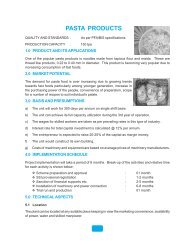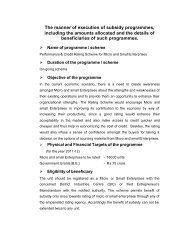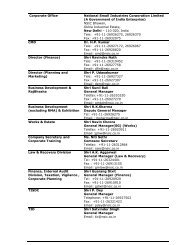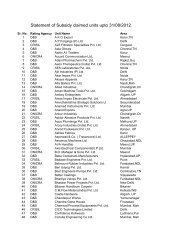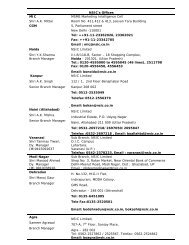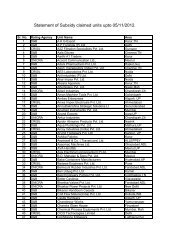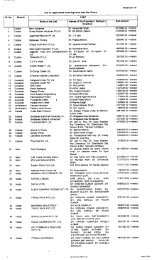Create successful ePaper yourself
Turn your PDF publications into a flip-book with our unique Google optimized e-Paper software.
PASTA PRODUCTS<br />
QUALITY AND STANDARDS : As per PFA/BIS specifications<br />
PRODUCTION CAPACITY : 150 tpa<br />
1.0 PRODUCT AND ITS APPLICATIONS<br />
One of the popular pasta products is noodles made from tapioca flour and maida. These are<br />
thread like products, 0.22 to 0.40 mm in diameter. This product is becoming very popular due to<br />
increasing consumption of fast foods.<br />
2.0 MARKET POTENTIAL<br />
The demand for pasta food is over increasing due to growing trends<br />
towards fast foods particularly among younger generation, increase in<br />
the purchasing power of the people, convenience of preparation, scope<br />
for a number of recipes to suit individual's palate.<br />
3.0 BASIS AND PRESUMPTIONS<br />
a) The unit will work for 300 days per annum on single shift basis.<br />
b) The unit can achieve its full capacity utilization during the 3rd year of operation.<br />
c) The wages for skilled workers are taken as per prevailing rates in this type of industry.<br />
d) Interest rate for total capital investment is calculated @ 12% per annum.<br />
e) The entrepreneur is expected to raise 20-25% of the capital as margin money.<br />
f) The unit would construct its own building.<br />
g) Costs of machinery and equipment are based on average prices of machinery manufacturers.<br />
4.0 IMPLEMENTATION SCHEDULE<br />
Project implementation will take a period of 8 months. Break-up of the activities and relative time<br />
for each activity is shown below:<br />
v Scheme preparation and approval : 01 month<br />
v SSI provisional registration : 1-2 months<br />
v Sanction of financial supports etc. : 2-5 months<br />
v Installation of machinery and power connection : 6-8 months<br />
v Trial run and production : 01 month<br />
5.0 TECHNICAL ASPECTS<br />
5.1 Location<br />
The plant can be located at any suitable place keeping in view the marketing convenience, availability<br />
of power, water and skilled manpower.
5.2 Process of Manufacture<br />
The noodle is manufactured in different sizes, hollow as well as solid<br />
and cooked in different methods. Some are made for cooking and<br />
others are for frying. The manufacturing method for frying quality<br />
noodles is as follows:<br />
The average moisture content of dry mixes is 10-11%. The three<br />
ingredients, viz. maida, starch and sodium bicarbonate are dry blended<br />
in a vertical mixer alongwith edible colour. Dough is made from the above blend by using boiled<br />
water wherein a part of the starch is gelatinized. The ingredients are mixed in dough mixer for<br />
about 12 to 15 minutes. The kneaded dough is transferred to a noodle making machine wherein<br />
extruded material of desired shape and length is obtained by using an appropriate die and suitably<br />
adjusting the distance between the dye surface and cutting blade. The moisture content of the<br />
product at this stage is about 33%. The cut noodles from the cutting machine fall on wooden trays.<br />
The product undergoes surface drying and becomes hard enough to be handled without sticking or<br />
being crushed. The moisture content of the pre-dried product at this stage is about 30%. The predried<br />
product is finally semi-dried. The moisture content of the product is around 17%. The product<br />
is exposed to steam for 15 minutes and subsequently dried to 10% moisture level.<br />
6.0 POLLUTION CONTROL<br />
There is no major pollution problem associated with this industry<br />
except for disposal of waste which should be managed appropriately.<br />
The entrepreneurs are advised to take "No Objection Certificate" from<br />
the State Pollution Control Board.<br />
7.0 ENERGY CONSERVATION<br />
The fuel for the steam generation in the boiler is coal or LDO depending<br />
upon the type of boiler. Proper care should be taken while utilising the fuel for the steam production.<br />
There should be no leakage of steam in the pipe lines and adequate insulation should be provided.<br />
8.0 PRODUCTION CAPACITY<br />
Quantity : 150 tpa<br />
Installed capacity : 700 kg/day<br />
Optimum capacity utilization : 70%<br />
Working days : 300/annum<br />
Manpower<br />
Utilities<br />
: 12<br />
Motive Power : 25 kW<br />
Water : 10 kL/day<br />
Coal/LD oil : 125 kg/day
9.0 FINANCIAL ASPECTS<br />
9.1 Fixed Capital<br />
9.1.1 Land & Building Amount (Rs. lakh)<br />
Land 700 sq.mtr : 1.00<br />
Built up Area 225 sq. mtr. : 4.50<br />
------<br />
Total cost of Land and Building : 5.50<br />
9.1.2 Machinery and Equipment<br />
Description Amount (Rs. lakh)<br />
Vertical powder mixer cap 500 kg, : 3.25<br />
Dough mixer, noodle making extruder,<br />
Wooden trays , boiler, weighing scales,<br />
buckets, handling equipment<br />
Erection and electrification<br />
@ 10% of machinery cost : 0.33<br />
Office furniture & fixtures : 0.42<br />
Total : --------<br />
4.00<br />
9.1.3 Pre-operative Expenses<br />
Consultancy fee, project report, deposits with : 1.00<br />
electricity department etc.<br />
9.1.4 Total Fixed Capital : 10.50<br />
(9.1.1+9.1.2+9.1.3)<br />
9.2 Recurring expenses per annum<br />
9.2.1 Personnel<br />
Designation No. Salary Amount<br />
Per month (Rs.lakh)<br />
Factory Manager 1 8,000 0.96<br />
Supervisor 2 6,000 1.44<br />
Office Assistant 2 5,000 1.20<br />
Technician 2 4,500 1.08<br />
Skilled workers 1 3,000 0.36<br />
Unskilled workers 4 2,500 1.20<br />
6.24<br />
Perquisites @ 15% 0.94<br />
---- ------<br />
Total : 12 7.18<br />
87
9.2.2 Raw Material including packaging materials<br />
Particulars Qty.(MT) Rate/kg Amount<br />
(Rs. lakh)<br />
Maida 130 9 11.70<br />
Starch 20 10 2.00<br />
Salt, chemicals LS - 0.75<br />
Packaging material LS - 3.30<br />
---------<br />
Total: 17.75<br />
9.2.3 Utilities Amount (Rs. lakh)<br />
Power 0.50<br />
Water 0.05<br />
Fuel 0.15<br />
-------<br />
Total: 0.70<br />
9.2.4 Other Contingent Expenses Amount (Rs. lakh)<br />
Repairs and maintenance@10% 0.85<br />
Consumables & spares 0.35<br />
Transport & Travel 0.12<br />
Publicity 0.60<br />
Postage & stationery 0.08<br />
Telephone 0.07<br />
Insurance 0.08<br />
-------<br />
Total: 2.15<br />
9.2.5 Total Recurring Expenditure Amount (Rs. lakh)<br />
(9.2.1+9.2.2+9.2.3+9.2.4) 27.78<br />
9.3 Working Capital<br />
Recurring Expenditure for 3 months 6.95<br />
9.4 Total Capital Investment Amount (Rs. lakh)<br />
Fixed capital (Refer 9.1.4) 10.50<br />
Working capital (Refer 9.3) 06.95<br />
----------<br />
Total: 17.45<br />
88
10.0 FINANCIAL ANALYSIS<br />
10.1 Cost of Production (per annum) Amount (Rs. lakh)<br />
Recurring expenses (Refer 9.2.5) 27.78<br />
Depreciation on building @5% 00.25<br />
Depreciation on machinery @10% 00.36<br />
Depreciation on furniture @20% 00.08<br />
Interest on Capital Investment @12% 02.01<br />
--------<br />
Total: 30.48<br />
10.2 Sale Proceeds / Annual turnover<br />
Item Qty. Rate Amount (Rs.lakh)<br />
(MT) per kg<br />
Noodles 150 24 36.00<br />
10.3 Net Profit per year<br />
= Sales - Cost of production<br />
= 36.00 - 30.48<br />
= Rs. 5.52 lakh<br />
10.4 Net Profit Ratio<br />
= Net profit X 100<br />
= 5.52X 100<br />
Sales<br />
36<br />
= 15.33%<br />
10.5 Rate of Return on Investment<br />
= Net profit X 100<br />
= 6 X 100<br />
Capital Investment<br />
17.3<br />
= 34.7 %<br />
89
10.6 Annual Fixed Cost Amount (Rs. Lakh)<br />
All depreciation 0.69<br />
Interest 2.01<br />
40% of salary, wages, utility, contingency 3.98<br />
Insurance 0.08<br />
——<br />
Total: 6.76<br />
10.7 Break even Point<br />
= Annual Fixed Cost X 100<br />
= 6.76 X 100<br />
Annual Fixed Cost + Profit<br />
= 53%<br />
6.76 +6.00<br />
11.0 ADDRESSES OF MACHINERY AND EQUIPMENT SUPPLIERS<br />
M/s. Mona Machinery Mfg. Co.<br />
Chandralok, 111 SD Road,<br />
Secunderabad (A.P.)<br />
M/s. Khan Engg. Works,<br />
5-5-274 Nampally,<br />
Near Gandhi Bhavan,<br />
Patel Nagar<br />
Hyderabad<br />
PPM International<br />
70, Rama Road,<br />
New Delhi –110 015<br />
12.0 OTHER SPECIAL FEATURES<br />
M/s. Shanti Turning Works<br />
4-1-590/12, Troop Bazar,<br />
Hyderabad – 500001<br />
M/s. Mahalaxmi Engg. Works,<br />
Craftman, Gylid, Mallepally,<br />
Hyderabad<br />
M/s. Debdoot India,<br />
67-B, Biddan St.,<br />
Kolkata - 700006<br />
A careful selection of product mix is necessary based on the local market demand and<br />
availability of raw materials. The facilities can also be utilised to manufacture other pasta<br />
products with local recipes for fuller utilisation of capacity.



